1000/1000
Hot
Most Recent

Natural products with biological activity represent a primary source of commodities ranging from human nutrition to therapy. Also they may represent cosmetic principles and/or recreational tools. These natural means have been used by mankind for centuries, if not millennia. They are commonly used all over the world in socio-economical contexts, but are particularly attractive in disadvantaged areas or economically emerging situations all over the world because of their accessibility and low cost/use ratio.
Bioactive natural products are widely diffused in alternative and popular medicine; possibly, one of the best-known examples is represented by the neem tree and its products. The usage of neem fruits, leaves and even bark is described in religious Hindu works and in the Ayurvedic medicine, where it is indicated by the Sanskrit name of “sarva roga nivarini” (universal healer of all illnesses). Allegedly, the Mahatma Gandhi used to meditate and pray under the foliage of a neem tree to find inspiration and tranquility and, actually, consumed neem leaves with his daily diet, see also the web site http://www.natureneem.com/index.htm. However, in the light of the updated scientific literature, the all-healing, all-purpose character of neem products remains to be fully demonstrated [1][2]. The usage of natural products ranges from nutraceutics to human/veterinary health care and therapies as well as to cosmetics. Just to give an idea about the number and diffusion of natural substances one should be aware of, a search in common literature databanks, using the keyword “natural products”, will score about 80,000 entries (as of September 2021). Therefore, this topic is of utmost interest for the general reader, but also for related economical and industrial enterprises [3][4]. As mentioned above, natural products find a use in many fields of daily life: this mostly applies to areas of the world where traditional medicine is practiced for a number of different reasons; essentially, proximity and easy access to natural principles, fairly uncontaminated environment, and low-cost/benefit ratio of the product in question. It should be pointed out, however, that the use products of natural origin are also becoming ever more popular in areas of the economically advanced world. If this is due to a return to a healthier lifestyle or to a snob-like attitude is hard to tell. However, in any case, examining these aspects, though very interesting, do not fall within the boundaries of this contribution.
Vonenina
Seven species of the ornamental plant periwinkle are endemic to Madagascar. The plant is native to the Ile Rouge as it also known in French, but it has propagated to other geographical areas among which: India, Sri Lanka, Sierra Leone, Malaysia, and Australia. The plant has a number of different common names such as “bright eyes”, “graveyard plant”, “old maid” or “rose periwinkle maid”. The Catharanthus roseus (or Vinca rosea) is the source of an active principle known with the Malagasy name of vonenina. The plant has other names in Madagascar, such as: tsmatiririnina, befela or salotsa, depending on tribal language and ethnic context such as Merina and Betsileo, which are the main, and historically speaking most influential, indigenous tribes. The Madagascan periwinkle has been known for a long time as an herbal medicine, although it has also found a very common usage as an ornamental plant. Usage of the active principles of this plant are not limited to the Madagascan popular pharmacopeia. As a matter of fact, Ayurvedic and Chinese traditional medicines recommend the extracts of roots and shoots as medicament for different diseases, among which are diabetes and malaria. However, if assumed orally, C. roseus can be extremely toxic to humans. In more recent times, vinca-alkaloids purified from this plant, include vinblastine and vincristine, which under a chemical point of view molecular analogues. Presently, these natural compound derivatives have a very relevant role in human medicine since these molecules are used as chemotherapeutic agents: namely in the treatment of different types of cancer such as leukemia and Hodgkin’s lymphoma, acute lymphocytic and myeloid leukemia, non-small cell lung cancer, bladder cancer, brain cancer, melanoma, as well as testicular cancer. Administration is done intravenously. Both drugs are included in the WHO list of Essential Medicines http://apps.who.int/iris/handle/10665/325771. However, the pure molecules, vinblastine and vincristine, are nowadays produced by chemical synthesis. In tumor cells the molecular action of vinblastine consists of its binding to tubulin which inhibits microtubule assembly; this ends in cell cycle arrest in the M phase. The result is the disruption of microtubule assembly and severe hindrance of formation of mitotic spindles as well as kinetochore assembly. Consequently, the separation of chromosomes during the mitotic anaphase is thus dramatically impaired (Vinca rosea pictorials and the chemical generalities of the antitumor molecules derived from the plant are reported in Figures 1 and 2). About 180 species of honeysuckle species belonging to the genus Lonicera exist. They are diffused in North America and Eurasia. The term Lonicera was created by Karl von Linné (Karolus Linneus) in the mid-seventeenth century, adopting in Latin the name Lonitzer as a tribute to the botanist Adam Lonitzer. These plants are also known under the common name of caprifolium, which derives from the Latin word goat (capra) and leaf (folium), referring to the habit that this ovine graze on the leaves of some of these plant species.
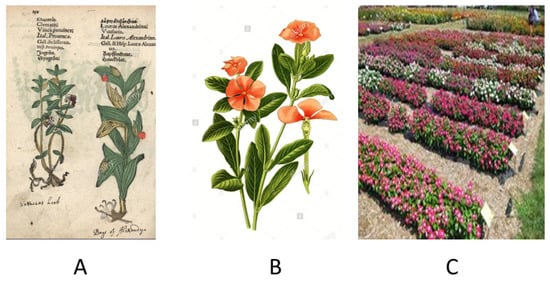
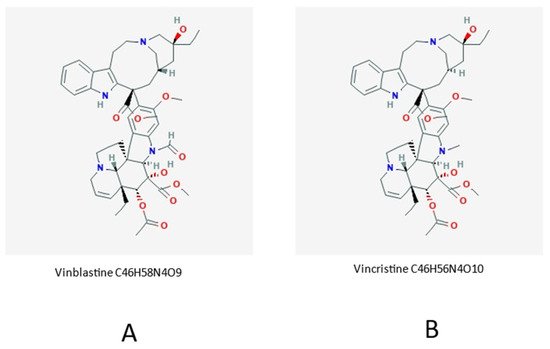
Lantana and Marigold.
Neither plant is actually native to Madagascar. However, bioactive products of both plants find an use in the Malagasy popular/traditional medicine. The native habitat of Lantana camara (common lantana) is Central, South America and American tropics; however, due to its extremely invasive character the plant has spread to over 60 countries worldwide, including temperate areas in south Europe. Other common names of L. camara are Spanish flag, big-sage (Malaysia), wild-sage, red-sage, white-sage (Caribbean), korsu wiri (korsoe wiwiri) (Suriname), tickberry (South Africa), West Indian lantana, umbelanterna, putus in Bengal and Gu Phool in the Assam region (India). This plant is known in Madagascar by different names, such as radriaka, falavelona or fankataviakoho, depending on the local tribal languages. However, the definition of falavelona is also used for the plant Jatropha curcas. The plant was introduced from tropical America, possibly by voyagers and merchants. But the Northern coasts of the island have also been known for pirate activities which could have generated import and/or exchange of goods. The wound healing properties of the juice of Madagascar’s Lantana camara, in any case, were discovered upon the vast and capillary spreading of this plant into the new habitat. The lantana leaf juice and essential oil constitute the basis for Radriaka, a commercial preparation produced in Madagascar. This is often confused with the drug Madécasol (or Madecassol, originally produced by Bayer), which is actually obtained from the Centella species. However, both preparations are utilized as a cicatrizant, in addition to other disparate discomfort situations such as antispasm, antiviral, emmenagogue, and febrifuge. Therefore, it is used to alleviate many conditions among which are: ulcers, wounds, cuts, chronic bronchitis and asthma, viral infections, as well as to induce and/or regulate menstruation. Also, an infusion (tea) is used as a beverage and wash to alleviate scabies and cure common colds. Tea and steam baths are used as an antipyretic and against shakes [4]. See https://en.wikipedia.org/wiki/Lantana_camara for further details. The plant Tagetes minuta, also known with the common name of marigold is an annual species native to South America; it was introduced to Madagascar as an ornamental plant and is now naturalized throughout the highlands. As a matter of fact, it also grows at relatively high altitudes in the Antananarivo area and its surroundings such as Ankatso, Alasora and Ambohimangakely (where the average altitude is about 1200 m above sea level). Oils of Tagetes minuta from various countries have been investigated for their chemical composition, showing large differences in percentages of the main compounds: oils extracted from Madagascan marigold plant have been investigated in detail [5]. Essential oil preparations, in association with Calendula officinalis products, have been used in a number of podiatric conditions, including the hallux valgus or other skin lesions [6]. In particular, a decoction of leaves of Tagetes erecta, also commonly known as Aztec or African marigold, has traditionally been used for the treatment of malaria in Madagascar, while the roots are used for their insecticidal and nematocidal activities, possibly due the thienyl compounds found therein [5][6][7][8][9][10].
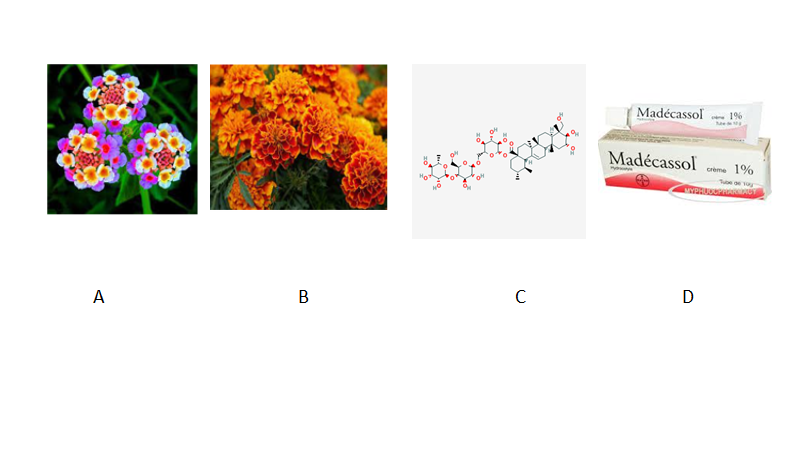
Figure 3. A. Inflorescences of Lantana. The flowers of this plant are found in many beautiful colors. The perfume of flowers and leaves is a sort of tutti-frutti like smell. The blooming is abundant and spectacular with flowers produced from late spring to fall; B. Plants of marigold may belong to genus Calendula or Tagetes, and actually which plant is used and to which purpose may be confusing. Several species Tagetes erecta are known such as: African marigold, Aztec marigold, French marigold depending on their geographic origin. In any case, phyto-pharmacological studies have suggested that these plant extracts may have anti-viral, anti-genotoxic, and anti-inflammatory properties in vitro, and alcoholic extracts showed antibacterial activity and antifungal activities. In some areas of the world Calendula petals and extracts are used as cosmetics, probably because they contain saponins, resins, and essential oils. In some areas of the world, they also find a culinary usage. C. Chemical formula of madecassol (molecular mass: 975.12) also known as madecassoside (official name) or asiticoside. It is a triterpenoid compound found in Centella asiatica and is used as herbal medicament in traditional African medicine but also in Chinese and Ayurvedic medicine. Madecassoside has, allegedly, many biological activities including, anti-inflammatory, wound healing, and antioxidant activities. The molecule is claimed to have a neuroprotective action and therefore may reduce stroke-derived damages. Madecassoside inhibits melanin synthesis thus blocking ultraviolet-induced inflammation. D. A commercially available cream preparation of Madecassol.
Vanilla.
A work on the Madagascan officinal plants could not neglect to cite two more natural products originating from this country: vanilla and masonjoany. Vanilla is obtained from orchids of the genus Vanilla , primarily obtained from pods of the Mexican species, flat-leaved vanilla. The plant actually originates from Central America, where pre-Columbian Mesoamericans cultivated the vine of the vanilla orchid. The Aztec word for vanilla is tlīlxochitl. Vanilla is a deformation of the Spanish word vaina (sheath); vanilla thus means little sheath. Three major species of vanilla are currently grown all over the world: the V. planifolia (also named V. fragrans), which is found in Madagascar, La Réunion, and other tropical areas along the Indian Ocean; V. tahitensis, grown in the South Pacific; and V. pompona , found in the West Indies, Central America, and South America. However, the most appreciated product is the bourbon vanilla (after the former name of the island La Réunion, Île Bourbon) or Madagascar vanilla. This product of this cultivar (Vanilla planifolia) is produced in Madagascar and neighboring islands as well as in Indonesia. Madagascar and Indonesia provide two-thirds of the world’s supply of vanilla, but some African countries and Sri Lanka are becoming imortant competitors in the the production of vanilla. Saffron is the only spice with a market value higher than vanilla: but this latter owes its cost essentilally to the labor-expensive and cultivation/harvest procedures. Apart from aroma-therapy, no medicinal applications for vanilla are known. Nevertheless, vanilla is highly appreciated in industrial and domestic baking, and perfume manufacture. From a chemical point of view, vanilla essence is a complex mixture of several hundred different compounds, including vanillin, major acetaldehyde, acetic acid, furfural, hexanoic acid, 4-hydroxybenzaldehyde, eugenol, methyl cinnamate, and isobutyric acid. Synthetic essence consists of a solution of synthetic vanillin in ethanol. The chemical compound vanillin (4-hydroxy-3-methoxybenzaldehyde) is a contributor to the characteristic flavor and aroma of real vanilla and is the main flavor component of cured vanilla beans (https://cen.acs.org/articles/94/i36/problem-vanilla.html).Vanillin was first isolated from vanilla pods by Gobley in 1858 [11]. Most artificial vanilla products contain vanillin, which can be produced synthetically from lignin, a natural polymer found in wood. Curiously, synthetic vanillin is also a by-product from the pulp used in papermaking, in which the lignin is broken down using sulfites or sulfates.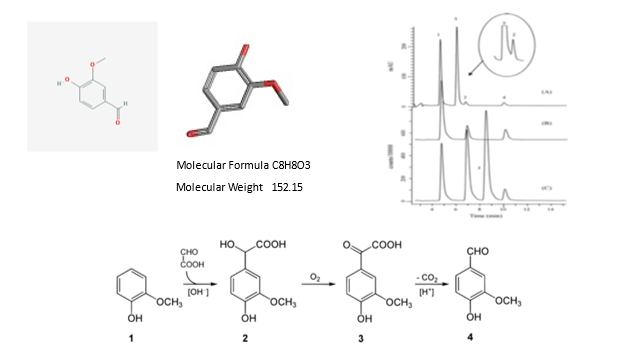
Figure 4. Upper Panel, from left to right. Chemical structures and formulas of vanillin. Chromatographic analysis of vanillin and molecular analogues: vanillin (peak 1), ethyl-vanillin (peak 2) and coumarin (peak 3). Lower Panel. Vanillin may be produced semi-synthetically from eugenol (starting molecule), or complete chemical synthesis. The lower panel illustrates a process developed at Rhodia in the 1970s of last century: the company was specialized in chemistry, synthetic fibers and polymers. Subsequently it merged into a large multinational concern (See https://en.wikipedia.org/wiki/Rhodia_(company). In the original synthetic pathway, guaiacol (1) reacts with glyoxylic acid by electrophilic aromatic substitution. The resulting vanillylmandelic acid (2) is then converted by 4-Hydroxy-3-methoxyphenylglyoxylic acid (3) to vanillin (4) by oxidative decarboxylation. Blind testing panels, failed to distinguish between the flavors of synthetic vanillin from lignin and those from guaiacol but can distinguish the odors of these two types of synthetic vanilla extracts. (https://en.wikipedia.org/wiki/Vanillin#:~:text=Vanillin%20is%20an%20organic%20compound,extrac t%20of%20the%20vanilla%20bean).
Masonjoany.
Masonjoany (pronounced in French as Massounjouany or Massunjun) is possibly one of the most intriguing Madagascan natural products. Even the plant from which this product is obtained has an uncertain taxonomy: it is known with the scientific names of Enterospermum madagascariensis, Santalina madagascariensis or Coptosperma madagascariensis. It has different common names as Madagascar Santal, or Tabaky in the Southern areas of the country. The Masonjoany or sandalwood of Madagascar is a common endemic shrub that grows on the west coast of the island. However, the Madagascan sandalwood does not share anything with the sandalwood from India (Santalum species) which is utilized to produce essential oils and incense. However, stumps and roots of the Madagascan plant contain an odorous volatile oil which may remind a sandalwood-like fragrance. The tree Santalina madagascariensis grows in many different places and in very localized areas in Madagascar. Scientific literature of the products of E. madagascariensis is scant if existing. A work was published on the sesquiterpenoids content of this plant extracts, but not much more if found in literature [12]. Women of the Sakalava e Vezo people on the coast of Nosy Be, Diego Suarez and Tuléar (but on the Mascarene Islands as well) manufacture this beauty and protective cream grating a piece of Masonjoany on a coral stone with some water and oil. The emulsion is applied to the face; the facial beauty mask is kept all day, but it crumbles away rapidly. This preparation is used as face painting, during traditional ceremonies but also during the elections of Miss Madagascar. Several features in addition to sunscreen are attributed to Masonjoany i.e: antiaging, eliminating skin impurities and skin cleansing properties. One of the Authors (G.R.) received information from a woman personally interviewed in a street of Antananarivo, that this yellow paste is spread on the face of mourning widows. However this information must be considered unwarranted if not apocryphal.
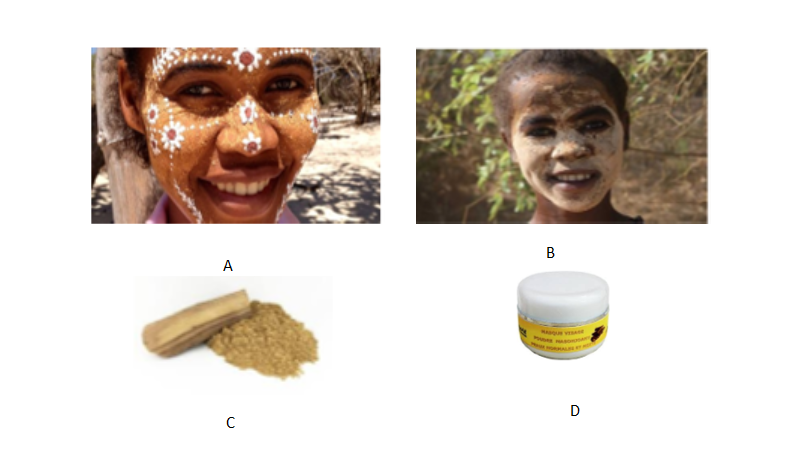
Figure 5. Upper panel, A and B.Two Madagascan women with Masonjoany cream spread on the face. The crumbling of the paste is clearly visible on the face of the woman in B. Lower panel, C.Stone and grated wood crumbles. D. A commercially available cream preparation of Masonjoany. The private company Renala, based on the West coast of Madagascar, in the Morondava area, is a producer of virgin botanical natural ingredients and oils for cosmetic and nutraceutical industries.
In conclusion, the native Malagasy flora is rich, and the country presents a great biodiversity both in the plant and, animal kingdom as well as in ethnology, therefore the amount of ethnobotanical information is extensive. Just to give a final example, various plants of the Dianella genus are utilized differently by the Tanala and Betsimisaraka people. In the Ranomafana region, Tanala people brew a tea from the leaves which is used to combat dysentery, while in Maroantsetra, the Betsimisarakas prepare a tea from the roots and stem used to reduce fever. Curiously, in Madagascar, certain plants are traditionally used for treating men, while other are used exclusively for women, for example, to treat general fatigue. Therefore, medicinal plants are indicated with high specificity. It has been claimed that a deeper analysis of such gender-specific plant “prescriptions” could shed some light on our understanding of the different effects of various compounds on the male and female physiology. Finally, an exhaustive and detailed review of Madagascan plants and their products as well as applications has been published [13]; see also [9][10] for general features of natural bioactive products. [3][4][10]
Drug absorption into any organ entails a complex behavior which depends on the chemical structure of the compound(s) to be delivered. This concept was anticipated by Hermann Müller, who prompted the discovery of nanometric needles capable to act directly on DNA and modify its features. A similar concept was taken up by Paul Ehrlich, a precursor of molecular medicine, who was convinced that the same target could be reached using the so-called “magic bullets” (“zauberkugeln”, according to the German definition). The features of a carrier are optimal when it acts like a projectile hitting the target's center spot. This represents the major challenge and aim in designing the chemico-physical features of cargo supramolecular carriers. Cargos guarantee the delivery, and uptake too, of molecules with different functional features. The optimal solubility of the drug to be delivered is crucial. Drugs are often transformed into acid salts when targeted to strongly polar tissues, or form complexes with crown ethers or calix-arenes. Sophisticated methods rely on drug transport by gels and dendrimers, carbon nanotubes, to mention but a few [13][14]. Carbon nanotubes and graphene composites are raising an enormous interest for their potential use as cargo molecules both in cultured cells and in whole organisms, even though some concern exists about their environmental and health impacts [15][16]. Biocompatibility, possibility of selective targeting and an advantageous cost/production ratio play an important role in their selection as therapeutic agents. The validity of liposomes as cargo particles is mainly due to their flexibility, since they operate as vehicles for DNA, RNA, and proteins, as well as small molecules such as hormones, natural compounds and/or drugs also of botanical origin. Liposomes based on cationic lipids are not found in nature but are synthesized in the chemical laboratory. They possess a net positive charge and therefore may promptly interact with negatively charged cell membrane and nucleic acids [17][18]. The possibility of using liposomes in cancer therapy exists, since cationic liposomes are able to specifically deliver their payload to embryologically different tissues. Moreover, the interaction of this type of liposome does not interfere with the morpho-functional features of the target cells, as results from optical and scanning force imaging as well as by NMR-metabolomic studies [19]. Finally, the antibacterial action of cationic liposomes has also been examined in antibiotic resistant pathogenic microorganisms. This action may derive from the ability of liposomes to increase the bacterial membrane permeability, with consequent higher susceptibility to drug uptake. Carbon nanotubes are graphene sheets organized in cylindrical structures, and they may be single- or multi-walled tubular structures. Nanotubes have an astonishingly high potential for application in biochemistry, nano-medicine, pharmacology, and industry such as avionics and space engineering [20][21]. Researchers will limit the discussion to drug delivery and potentialities in therapy. With respect to this, biocompatibility of carbon nanotubes, as well as other nanoparticles, must be evaluated in biological contexts capable to assess toxicity and immuno-tolerance, just to mention two fundamental aspects of the overall biocompatibility. The membrane is the first barrier encountered by nanotubes entering the cell. Due to the poor dispersibility of nanotubes in aqueous media, they mainly establish van der Waals interactions and self-organize in bundles, that may eventually cause cell membrane damage: Sometimes are too large to enter into cells. However, non-covalent carbon nanotubes/BSA complexes do not alter cell viability in murine fibroblasts, human embryonic kidney cells and murine macrophages. The supramolecular organization of nanotubes plays a role in their biocompatibility. For instance, nanotube crossing of the plasma membrane causes no alterations of the dielectric parameters of cell membranes, which indicates that, at least at a first glance, the nanoparticles do not damage membrane structure, function, and permeability [22].